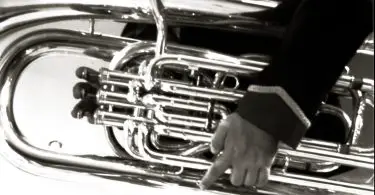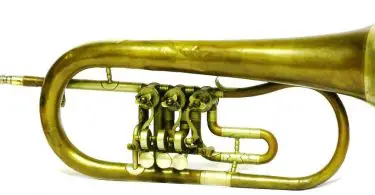Trombones are brass instruments, generally pitched an octave below a trumpet. They are versatile and are a mainstay across a wide spectrum of genres, including orchestras, brass bands, big bands, musical theatre pits, pop horn sections, and more. The trombone is a very full-sounding instrument capable of immense power across the range, from deep blast to a pure and clear high note, and anything in between.
Sound is generated by blowing air into the instrument through the mouthpiece, which vibrates inside the trombone’s column. Changing the length of the slide changes the pitch – a longer slide means a lower pitch. There are seven slide positions. In addition, different frequencies can be “buzzed” by the lips, which results in different notes from the harmonic spectrum, for each position. The slide and lips work together to produce the correct notes over a range spanning more than three octaves. The most common notes are viewable in the chart below.
Note that several notes, from the mid-range upwards, can be played in multiple positions (extra positions omitted in some upper cases), due to different combinations of lip buzzing frequency and slide position. This is a key element of trombone playing, and greatly increases the flexibility of the instrument.
Here are the basics of trombone anatomy.
The Bell
Trombones are identified not only by their slides but also by the look of their bells. The bell also determines the sound of the instrument. Trombone bells are most commonly made from bright yellow brass (70% copper and 30% zinc). But they may be made from gold brass, red (or rose) brass (having a high copper content), or sterling silver.
The instrument’s sound quality is impacted by its bell size and thickness, as well as the type of metal the bell is made out of. More advanced and professional musicians may prefer bells that have particular features. For example:
- bass trombones generally have larger bells than tenor trombones;
- jazz trombone bells are typically the smallest;
- symphonic trombone bells are the largest;
- a one-piece hand-hammered bell produces a higher quality sound than a two-piece bell.
The Bore
The bore, or inner diameter of the inner slide, ranges from .500″ (for students and beginners) to .547″ (for symphonic horns), up to .562″ (for bass trombones). The smaller the bore, the more condensed and brighter the sound will be. Larger bores exude a warmer, deeper, and bolder sound. The seasoned trombonist may select a bore size that best authenticates their style or genre of music.
Students and beginners want to select a trombone whose bore size is smaller. Typically, the smaller the bore, the more resistance (back pressure) the horn has. More resistance helps beginning players produce good tone quality more easily.
The F-Attachment
Modern rotary valves are used to lower the overall pitch by increasing the length of the instrument and guiding the airflow through the extended tubing. Notes may be played that are not otherwise possible as a result. Intermediate-level players may decide to add an F-attachment to their trombone. An F-attachment expands the horn’s capabilities. It adds low-range notes and helps makes playing certain types of passages easier.
F-attachments are either:
- standard (traditional) wrap, which has more bends, is more compact and increases resistance or
- an open wrap, which has fewer bends, that provides a more freer-blowing trombone.








Start the discussion at talk.hearthemusicplay.com